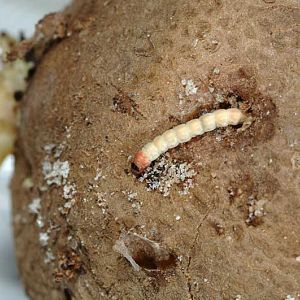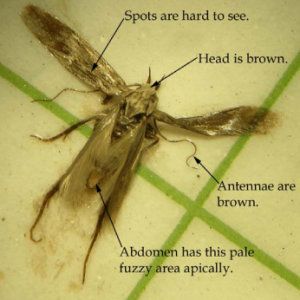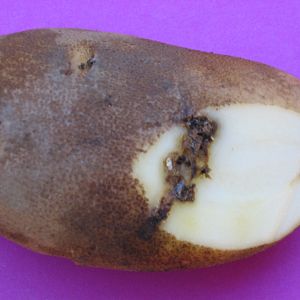Notes: Target PTW larvae feeding in the canopy in the weeks prior to vine desiccation or harvest. PHI is 6-days. Expect only 5-7 days of residual activity.
Notes: Target PTW larvae feeding in the canopy in the weeks prior to vine desiccation or harvest. PHI is 14 days. For best results, chemigate in 0.1-to-0.2-acre inches of water and add MSO at 12 to 16 fl. oz. per acre. Foliar sprays may not provide adequate control of larvae in the mid to lower canopy.
Notes: Target PTW larvae feeding in the canopy in the weeks prior to vine desiccation or harvest. PHI is 14-days.
Notes: Target PTW larvae feeding in the canopy in the weeks prior to vine desiccation or harvest. PHI is 7-days. Thorough coverage of foliage is essential. Use high water volumes with ground or aerial applications to ensure the product is well distributed in the foliage.
Notes: Tuberworm is not on the label but applications targeting other pests can control them. Apply in the weeks prior to vine desiccation or harvest when larvae are feeding in the foliage. The PHI is 21-days. Thorough coverage of foliage is essential. Use high water volumes with ground or aerial applications to ensure that the product is well distributed in the foliage. Use at least 0.5 inches of water per acre for chemigation.
Notes: Apply in the weeks prior to vine desiccation or harvest when larvae are feeding in the foliage. The PHI is 20-days. The avermectin in Athena will not improve control of tuberworm. Thorough coverage of foliage is essential.
Notes: Target PTW larvae feeding in the canopy in the weeks prior to vine desiccation or harvest. Baythroid XL has a 0-day PHI.
Notes: Target PTW larvae feeding in the canopy in the weeks prior to vine desiccation or harvest. PHI is 7-days. Ground or air application to dense canopies may not provide sufficient coverage or lower leaves, use sufficient water carrier. Use only 0.1 to 0.2-inches of water with chemigation.
Notes: Tuberworm is not on the label but applications targeting other pests can control them. Target PTW larvae feeding in the canopy in the weeks prior to vine desiccation or harvest. PHI is 1-day. Ground or air application to dense canopies may not provide sufficient coverage or lower leaves, use sufficient water carrier.
Notes: Target PTW larvae feeding in the canopy in the weeks prior to vine desiccation or harvest for knockback control. PHI is 7-days. Can be re-applied after 10 days.
Notes: Target PTW larvae feeding in the canopy in the weeks prior to vine desiccation or harvest. PHI is 7-days. For best results, chemigate in 0.1-to-0.2-acre inches of water and add MSO at 12 to 16 fl. oz per acre. Foliar sprays may not provide adequate control of larvae in the mid to lower canopy.
Notes: Target PTW larvae feeding in the canopy in the weeks prior to vine desiccation or harvest. PHI is 14-days. Repeat the application after 7+ days if needed to maintain control.
Notes: Target PTW larvae feeding in the canopy in the weeks prior to vine desiccation or harvest. PHI is 7-days.
Notes: Target PTW larvae feeding in the canopy in the weeks prior to vine desiccation or harvest. PHI is 21-days. Minimum re-treatment interval is 7-days.
Notes: Target PTW larvae feeding in the canopy in the weeks prior to vine desiccation or harvest. PHI is 14-days.
Notes: The label does not mention tuberworm, but it should provide some control. Target PTW larvae feeding in the canopy in the weeks prior to vine desiccation or harvest. PHI is 7-days. A spray adjuvant (OMRI-approved emulsified crop oil or methylated crop oil plus organosilicone) may improve control.
Notes: Target PTW larvae feeding in the canopy in the weeks before vine desiccation or harvest. If needed, follow-up with 2-3 applications at 7-10 day intervals.
Notes: Target PTW larvae feeding in the canopy in the weeks before vine desiccation or harvest. If needed, follow-up with 2-3 applications at 7-10 day intervals.




